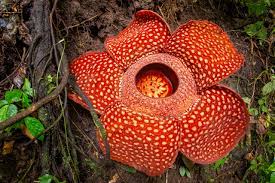Exploring the World’s Largest Flower – Rafflesia Arnoldii
The world is full of marvels, and the realm of nature never ceases to astonish us. In this article, we delve into the fascinating discovery of the world’s largest flower – the Rafflesia Arnoldii. This captivating revelation is not only a wonder of biodiversity but also an intriguing topic for students preparing for various government exams, such as teaching positions, police officers, banking, railways, defense, and civil services like PSCS to IAS.

Why this News is Important:
The Significance of Rafflesia Arnoldii: Rafflesia Arnoldii, commonly known as the corpse flower due to its pungent odor, holds immense importance in the realm of biology and conservation. Its colossal size and unique characteristics make it a crucial subject of study for students preparing for government exams in fields like biology, environmental science, and forestry.
Biodiversity Conservation Awareness: The discovery of such a rare and large flower highlights the importance of biodiversity conservation. It serves as a reminder of the need to protect and preserve our natural heritage. This topic might find its way into exam questions related to environmental policies and conservation efforts.
Historical Context:
Origins of Rafflesia Arnoldii: Named after Sir Thomas Stamford Raffles, a British statesman who served as the Lieutenant Governor of Java during the British occupation, Rafflesia Arnoldii was first discovered in the Indonesian rainforests in the early 19th century. Its striking appearance and unusual scent intrigued botanists and explorers, leading to further research and study.
Conservation Efforts: Over the years, the habitat of Rafflesia Arnoldii has been threatened by deforestation and habitat destruction. Conservationists and governments in countries like Indonesia and Malaysia have taken steps to protect this unique species and its habitat.
Key Takeaways from this News:
| Serial Number | Key Takeaway |
|---|---|
| 1. | Rafflesia Arnoldii is the world’s largest flower. |
| 2. | It is known for its foul-smelling odor. |
| 3. | This discovery highlights the importance of biodiversity conservation. |
| 4. | The flower was first discovered in the 19th century by Sir Thomas Stamford Raffles. |
| 5. | Conservation efforts are in place to protect its habitat. |
Important FAQs for Students from this News
What is Rafflesia Arnoldii?
Rafflesia Arnoldii is the world’s largest flower, known for its unique appearance and foul odor. It is native to the rainforests of Southeast Asia, particularly Indonesia and Malaysia.
Why is Rafflesia Arnoldii called the “corpse flower”?
Rafflesia Arnoldii is often referred to as the “corpse flower” due to its unpleasant smell, which resembles the odor of decaying flesh. This odor serves to attract flies and other insects that aid in pollination.
Who discovered Rafflesia Arnoldii?
Rafflesia Arnoldii was first discovered by the British statesman Sir Thomas Stamford Raffles, after whom it is named. He encountered the flower during his time in Indonesia in the early 19th century.
What is the historical context of Rafflesia Arnoldii’s discovery?
Rafflesia Arnoldii was discovered in the 19th century by Sir Thomas Stamford Raffles during British occupation in Java, Indonesia. Its unique features and scent intrigued early botanists and explorers, leading to further study.
Why is the discovery of Rafflesia Arnoldii significant?
The discovery of Rafflesia Arnoldii holds importance in the fields of biology and conservation. It sheds light on the incredible biodiversity of our planet and emphasizes the need for conservation efforts to protect such unique species and their habitats.
Some Important Current Affairs Links


















